Hey, fashion lovers! Ever imagined the vibrant world of Rajasthan’s hand-block printing meeting the modern denim jacket? Let’s explore Bagru block prints, a centuries-old craft, now finding its place in contemporary wardrobes as a symbol of eco-luxury and artisanal style.
This timeless craft has been practiced by the Chippa community for over 500 years, with natural dyes and intricately carved wooden blocks. Not many know that Bagru prints, traditionally used on cotton and silk, are now transforming denim jackets into wearable pieces of heritage.
Interestingly, a single handcrafted Bagru jacket can command prices between $80 and $300, reflecting the skill and labor invested by artisans.
So, let us take off and discover the cultural richness, artistic techniques, and modern appeal of Bagru block-printed denim jackets.
Introduction: The Timeless Art of Bagru Prints
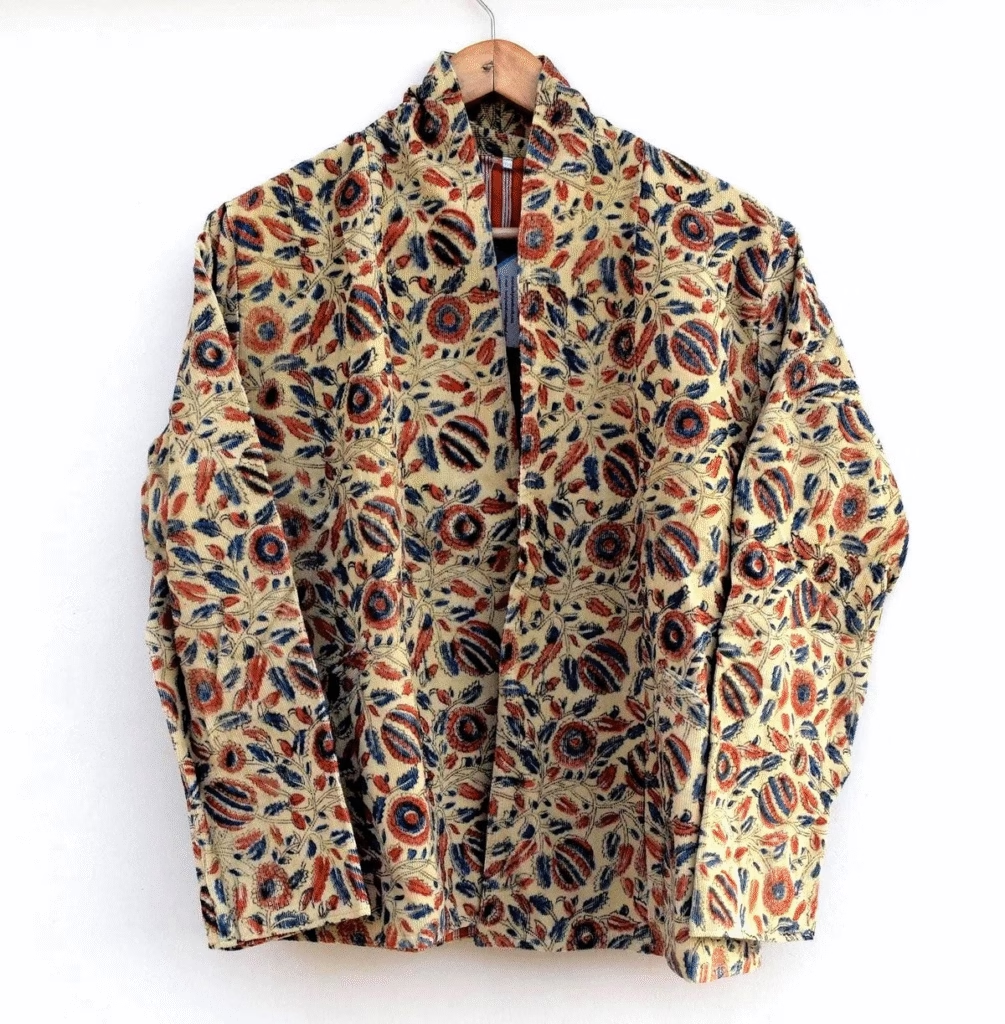
A Tradition That Transcends Time
Textiles are more than just clothing—they carry stories, heritage, and emotion. Bagru prints, originating in Rajasthan, are a perfect example of this. The artisans of Bagru use natural dyes, hand-carved wooden blocks, and centuries-old techniques to create designs that are rich in symbolism and aesthetics.
At first glance, what catches your eye are the paisleys, florals, and geometric patterns that adorn denim jackets today. But Bagru prints are more than decoration—they are a connection to centuries of craft, culture, and sustainable artistry.
Who are these artisans? How did Bagru prints evolve? And why have they become so sought-after in contemporary fashion? Let’s explore the amazing journey of this craft.
Bagru Block Printing: A Living Legacy
Before we delve into denim jackets, it’s important to understand the traditional art form:
- Origins: Bagru, a town in Rajasthan, has been a hub for hand-block printing since the 16th century.
- The Chippa Community: Artisans passed skills down generations, mastering block carving, dye preparation, and printing techniques.
- Natural Dyes: Extracted from indigo, pomegranate, and other plant-based sources, giving fabrics vibrant yet eco-friendly hues.
- Intricate Blocks: Wooden blocks are carved by hand, each representing motifs like flowers, peacocks, or geometric patterns.
Interestingly, over 70% of contemporary Bagru artisans are under 40, showing a growing interest in blending tradition with modern fashion.
Fashion Meets Tradition: Modern Appeal
- Styling: Layer over casual outfits or formal wear for a statement piece.
- Sustainability: Handcrafted with natural dyes, reducing chemical waste.
- Designer Collaborations: Fashion houses now incorporate Bagru prints in capsule collections.
- Global Recognition: These jackets are featured in exhibitions and fashion weeks internationally.
Did you know? The global demand for hand-block-printed apparel grew by 35% in the last five years, with Bagru prints contributing significantly.
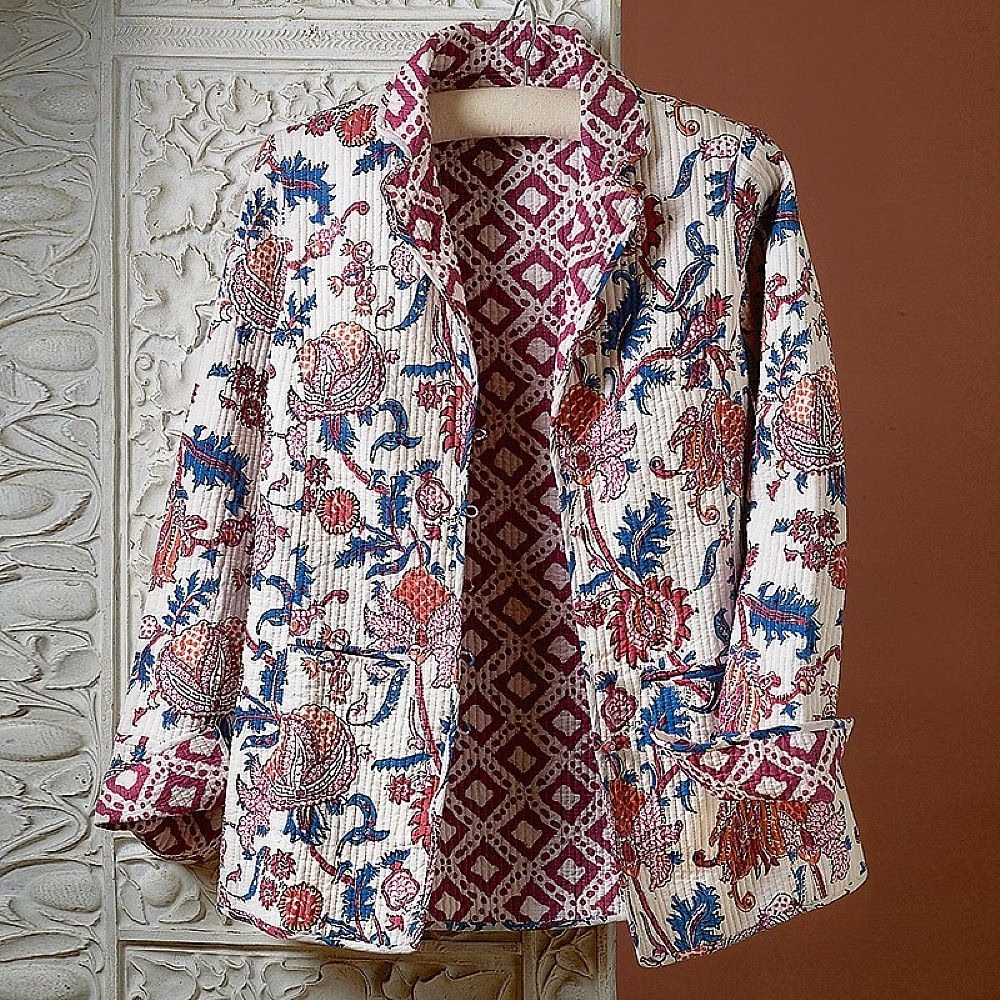
Motifs and Symbols in Bagru Block Print
Bagru block prints are not just patterns—they are stories, traditions, and symbols that have been passed down through generations of artisans. When adapted onto denim jackets, these motifs bring a unique blend of heritage and contemporary style, making each jacket a wearable piece of art.
Nature-Inspired Motifs: Celebrating the Earth
- Floral Designs: Roses, lotuses, and marigolds are frequently used to symbolize growth, beauty, and prosperity. Their intricate detailing reflects the artisan’s skill and patience.
- Leaves and Vines: Representing continuity and harmony, leaf patterns are often used to frame jackets’ shoulders, collars, and sleeves.
- Peacocks and Birds: Symbols of grace, elegance, and good fortune, these motifs are delicately hand-stamped, often on the back panels of jackets for maximum visual impact.
Geometric Patterns: Balance and Symmetry
- Triangles and Diamonds: These shapes are representative of stability and structure and often form repetitive patterns across pockets and sleeves.
- Checker and Lattice Designs: Adding texture and rhythm to the jacket, these patterns symbolize interconnectedness and visual balance.
- Circular Motifs: Often used as central motifs on the back of jackets, circles represent wholeness and continuity.
Cultural and Traditional Symbols: A Heritage Touch
- Paisleys: One of the most iconic Bagru motifs, paisleys represent fertility and life and are meticulously stamped on cuffs, collars, and panels.
- Elephants: Signifying strength, wisdom, and royal heritage, elephants are occasionally used as statement motifs in larger prints.
- Folk Elements: Stylized motifs inspired by local stories, temples, and festivals bring a cultural narrative to the fabric.
Adaptation for Denim: Modern Aesthetic
- Placement and Scale: On denim jackets, artisans adjust the size of motifs to highlight structural features like pockets, yokes, and cuffs.
- Contrast with Indigo: Traditional red, black, or natural ochre dyes create a stunning contrast against deep indigo denim, preserving the vibrancy of hand-block prints.
- Layered Motifs: Combining geometric, floral, and paisley designs allows each jacket to have a rich, multi-dimensional appearance, merging tradition with urban fashion.
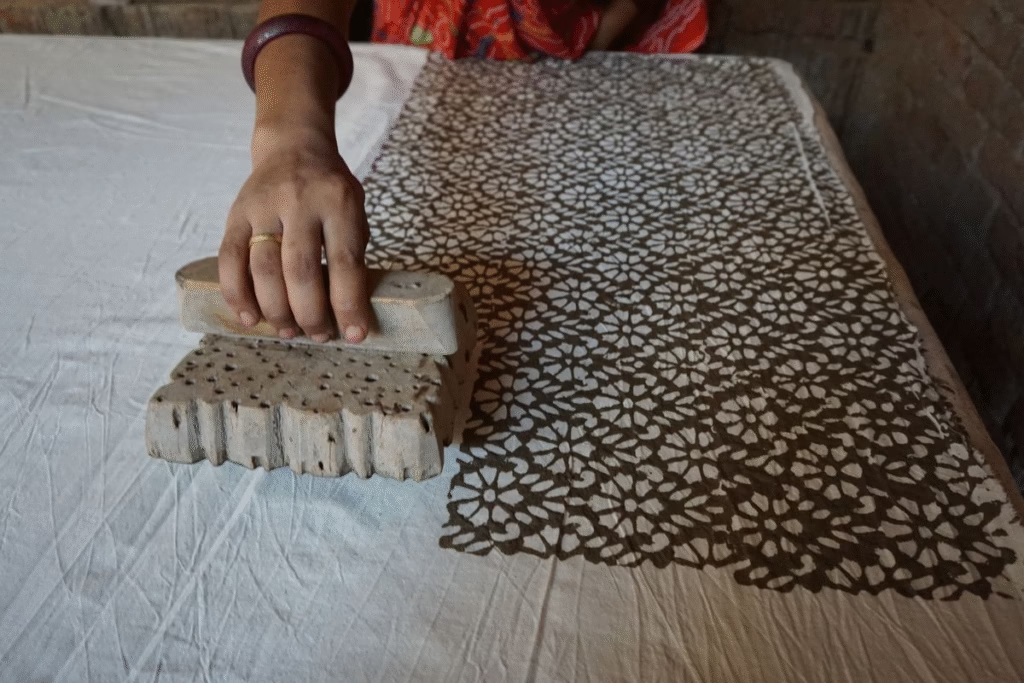
Materials and Steps in Bagru Block Printing
When we talk about Bagru block prints on denim jackets, two aspects form the backbone of this timeless craft: the materials used and the steps of making. Together, they preserve the authenticity of Bagru tradition while adapting to the sturdier fabric of denim. Let’s dive into these in detail.
Materials Used in Bagru Block Printing on Denim Jackets
The craft of Bagru relies heavily on natural, eco-friendly, and locally sourced materials. Every ingredient has a purpose, and artisans use them with remarkable precision.
1. Fabric Base: Denim as the Canvas
- Traditionally, Bagru printing was done on cotton and silk, but denim provides a contemporary, durable base.
- Denim’s strong weave allows motifs to retain clarity and sharpness, even after multiple washes.
- Indigo-dyed denim contrasts beautifully with the earthy colors of Bagru, such as reds, blacks, and yellows.
2. Wooden Blocks (Bunta)
- Hand-carved wooden blocks are at the heart of Bagru printing.
- Each block is carved from seasoned teak or sheesham wood for durability.
- Blocks feature intricate motifs such as paisleys, florals, leaves, vines, or geometric patterns.
- For denim jackets, blocks are often made slightly deeper and bolder to ensure the design penetrates the thick fabric.
3. Natural Dyes and Pigments
- Black Dye: Obtained from iron filings, jaggery, and water, producing a deep, rich black.
- Red and Maroon Shades: Derived from madder root or alizarin mixed with natural fixatives.
- Yellow and Ochre Tones: Extracted from turmeric, pomegranate rind, or harsingar flowers.
- Blue: Though denim is already indigo-dyed, artisans occasionally highlight motifs with indigo paste.
- These dyes are biodegradable and skin-friendly, ensuring eco-sustainability.
4. Mordants and Fixatives
- Mordants like alum and harda (myrobalan fruit) are essential for fixing colors onto the fabric.
- Harda also acts as a natural brightener, making prints sharper and longer-lasting.
- Alum helps bind colors like red and enhances dye absorption on denim.
5. Tools and Printing Essentials
- Printing Table: A padded surface covered with thick cloth, ensuring even stamping.
- Trays (Tari): Shallow wooden trays lined with felt, used for spreading dye evenly for block dipping.
- Brushes and Stirrers: Used to mix and maintain the consistency of natural dyes.
- Water Sources: Clean water is critical for washing denim before and after printing.
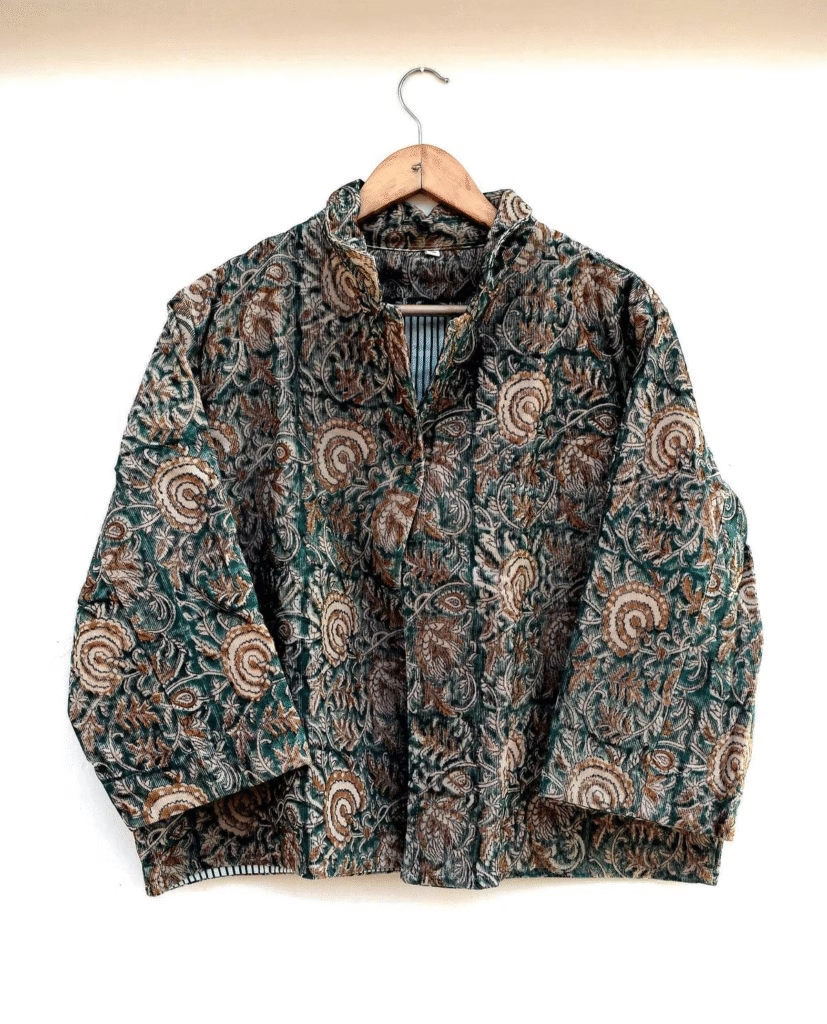
Steps of Making Bagru Block Prints on Denim Jackets
Bagru block printing is a multi-step process requiring patience, precision, and skill. Each stage is vital to ensuring the motifs remain crisp and vibrant on denim.
1. Pre-Washing and Preparing the Denim
- Jackets are thoroughly washed to remove starch, oils, or chemical residues.
- The fabric is soaked in a solution of harda (myrobalan) to improve dye absorption.
- Pre-treatment ensures prints bond well with the thick denim fibers.
2. Designing and Carving the Blocks
- Artisans sketch motifs on paper before transferring them to wood.
- Each block is carefully carved by hand, often taking several days for one detailed design.
- Blocks usually come in sets of three—outline, filler, and background—to create layered designs.
3. Preparing the Dyes
- Natural dyes are boiled, fermented, and mixed with mordants until the desired consistency is achieved.
- Dye trays are filled, and a felt lining is used so that blocks pick up just the right amount of pigment.
- Since denim is thick, dyes are sometimes prepared in stronger concentrations for deeper penetration.
4. Printing the Motifs
- The denim jacket is spread flat on the printing table.
- Blocks are dipped into dye trays and pressed firmly onto the fabric.
- Artisans align blocks with meticulous precision to maintain continuity of design.
- Repeated stamping ensures a seamless flow of patterns across panels, pockets, sleeves, and collars.
5. Drying the Fabric
- After printing, the jacket is dried under natural sunlight.
- Sun-drying not only saves energy but also enhances the natural shades of dyes.
- This step can take several hours to a full day depending on weather conditions.
6. Fixing the Colors
- Jackets are dipped in alum or post-treated with mordants to fix the colors permanently.
- This prevents motifs from fading or bleeding during washes.
- For darker tones, the printed jackets are often steamed to lock in pigments.
7. Washing and Finishing
- After fixation, jackets are thoroughly washed in running water to remove excess dye.
- They are then sun-dried again to reveal crisp, vibrant motifs.
- Finally, artisans check for alignment, touch-ups, and quality before the jacket is ready.
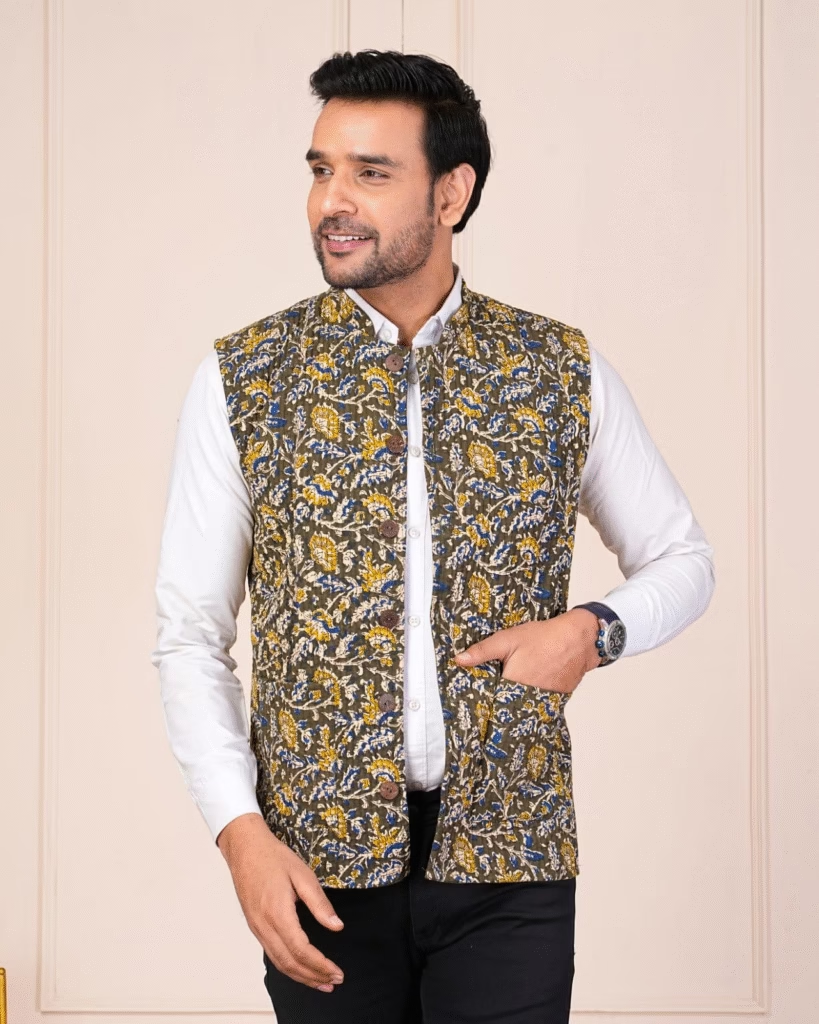
Risk Factors: How Bagru Denim Jackets Can Be Damaged
While Bagru prints on denim are durable, some risks may reduce their lifespan:
- Color Bleeding: Natural dyes may fade or bleed if washed with harsh detergents.
- Shrinkage: Denim may slightly shrink if exposed to high heat washing or drying.
- Abrasion Damage: Friction from frequent wear or rough surfaces can cause motifs to fade unevenly.
- Chemical Exposure: Bleach, strong detergents, or fabric softeners can damage both the denim fibers and block prints.
- Over-Washing: Frequent washing reduces the vibrancy of hand-printed colors.
Keeping the Printing Colors Safe
To ensure the Bagru prints retain their vibrancy and do not fade quickly, specific steps should be followed:
- Use Mild Detergents: Always wash with eco-friendly, pH-neutral soaps instead of harsh detergents.
- Cold Water Wash: Prefer cold water to prevent dye bleeding.
- Gentle Hand Wash: Machine wash is risky; opt for gentle hand wash to reduce abrasion.
- Turn Inside Out: Always flip the jacket before washing to protect printed surfaces.
- Air Dry in Shade: Direct sunlight may dull colors; shade drying helps maintain dye brightness.
- Avoid Dry Cleaning with Chemicals: Traditional chemical dry cleaning can harm natural dyes.
Washing and Care Safety Tips for Bagru-Printed Denim Jackets
Proper care ensures the longevity of both the denim and the traditional prints:
- First Wash Separately: Natural dye colors may bleed initially, so wash separately.
- Minimal Washing: Do not wash after every wear; spot clean when possible.
- Use Vinegar Soak (Occasional): A mild vinegar soak helps lock in natural dye pigments.
- Avoid Bleach & Hot Water: Both are harmful to prints and denim fibers.
- Steam Iron Only: If ironing is necessary, use a low-heat steam setting and always place a cotton cloth over the printed area.
- Storage: Store jackets in a cool, dry place, preferably hung up, and avoid prolonged exposure to moisture to prevent mildew.
Revival and Global Recognition
Efforts to preserve and promote Bagru block printing are gaining momentum:
- Government Support: Initiatives, grants, and GI tags help artisans sustain their craft.
- Digital Platforms: Social media campaigns showcase jackets to global buyers.
- Designer Collaborations: Fusion with modern fashion creates limited edition collections.
- Sustainability Appeal: Eco-conscious consumers are increasingly buying Bagru jackets.
Statistics show that exports of Bagru-printed garments increased by 40% over the past decade, reflecting both cultural appreciation and commercial viability.
The Bottom Line
Bagru block-printed denim jackets are not just clothing; they are an ode to craftsmanship, culture, and sustainability. Each paisley, floral, and geometric design tells a story of heritage, skill, and artistry.
Even today, these jackets continue to charm fashion enthusiasts worldwide, proving that true art—whether on canvas or denim—is timeless. The next time you slip into a Bagru block-printed jacket, remember, you are wearing history, tradition, and creativity stitched together.
Also Read:- Muga Silk from Assam: Eco-Luxury Fashion for Urban Professionals

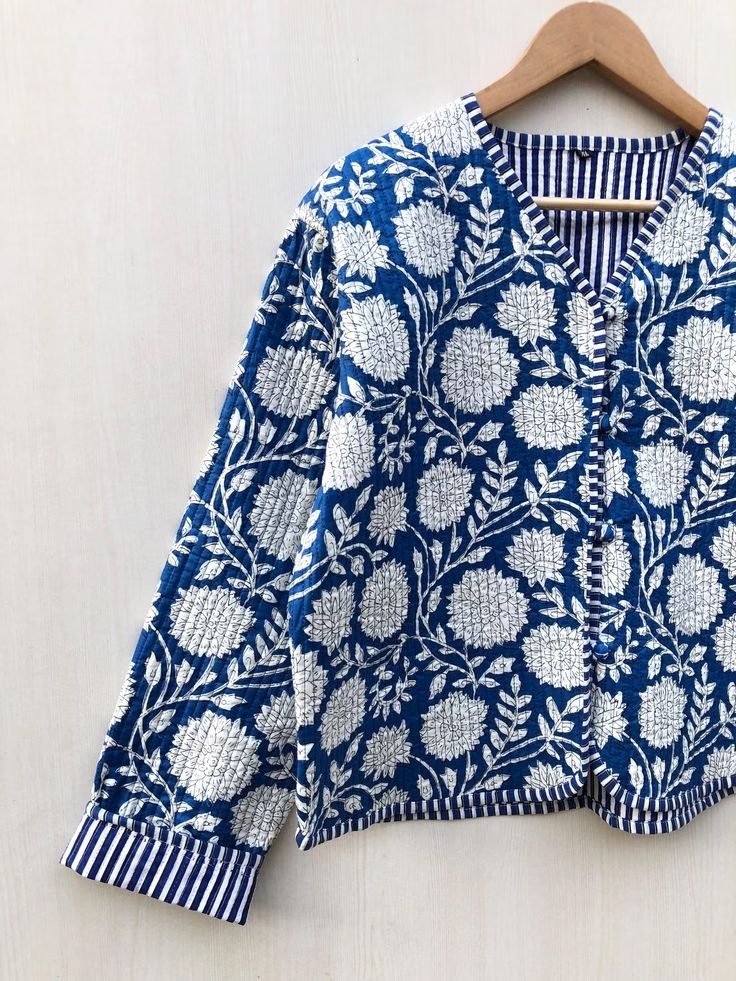
Leave a Reply